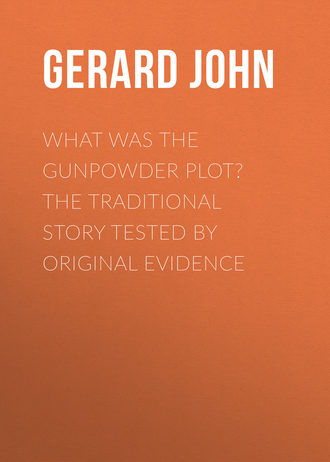 полная версия
полная версияWhat was the Gunpowder Plot? The Traditional Story Tested by Original Evidence
426
Commons' Journals.
427
In the preamble of the Act so passed we read: "Forasmuch as it is found by daily experience, that many his Majesty's subjects that adhere in their hearts to the popish religion, by the infection drawn from thence, and by the wicked and devilish counsel of jesuits, seminaries, and other like persons dangerous to the church and state, are so perverted in the point of their loyalties and due allegiance unto the King's majesty, and the Crown of England, as they are ready to entertain and execute any treasonable conspiracies and practices, as evidently appears by that more than barbarous and horrible attempt to have blown up with gunpowder the King, Queen …" etc., etc.
428
Negotiations, p. 256.
429
"Our parliament is prorogued till the 18th of next November. Many things have been considerable in it, but especially the zeal of both Houses for the preservation of God's true religion, by establishing many good laws against Popery and those firebrands, Jesuits, and Priests, that seek to bring all things into confusion. His Majesty resolveth once more by proclamation to banish them all; and afterwards, if they shall not obey, then the laws shall go upon them without any more forbearance." – Cecil to Winwood, June 7th, 1606 (Winwood, Memorials, ii. 219).
430
In the Dictionary of National Biography, and Doyle's Official Baronage, this installation is erroneously assigned to 1605.
431
Chronicle, p. 408.
432
Continuation of Stowe's Annals, p. 883.
433
Letter iii.
434
At Northumberland's trial Lord Salisbury thus expressed himself: "I have taken paines in my nowne heart to clear my lord's offences, which now have leade me from the contemplation of his virtues; for I knowe him vertuous, wyse, valiaunte, and of use and ornamente to the state… The cause of this combustion was the papistes seekinge to restore their religion. Non libens dico, sed res ipsa loquitur." – Hawarde, Les Reportes, etc.
435
History, vii. 84, note. On this subject Mr. Sawyer, the editor of Winwood (1715), has the following remark: "We meet with some account of his [Northumberland's] offence, though couched in such tender terms, that 'tis a little difficult to conceive it deserved so heavy a punishment as a fine of £30,000 and perpetual imprisonment." (Memorials, iii. 287, note.)
436
To Winwood, Memorials, iii. 287.
437
Traditional Memoirs, p. 214.
438
An Answere to certaine Scandalous Papers, scattered abroad under colour of a Catholicke Admonition. "Qui facit vivere, docet orare." Imprinted at London by Robert Barker, Printer to the King's most Eccellent Majestie. Anno 1606.
439
On this subject Cornwallis wrote to Salisbury (Winwood, ii. 193): "Many reports are here spread of the Combination against your Lordship, and that five English Romanists would resolve your death. It seems that since they cannot be allowed Sacrificium incruentum, they will now altogether put in use their sacrifices of blood. But I hope and suppose that their hearts and their hands want much of the vigour that rests in their wills and their pens. Your Lordship doth take especial courage in this, that they single you out as the chief and principal watch Tower of your Country and Commonwealth, and turn the strength of their malice to you whom they hold the discoverer of all their unnatural and destructive inventions against their prince and country," etc.
This was published in January, 1605-6, on the 28th of which month Sir W. Browne, writing from Flushing, mentions that "my lord of Salisbury hath lately published a little booke as a kynd of answer to som secrett threatning libelling letters cast into his chamber." (Stowe MSS., 168, 74, f. 308.)
440
P.R.O. Dom. James I. xviii. 97, February 27th, N.S., 1606. The original, which is in Latin, has been utterly misunderstood by the Calendarer of State Papers.
441
Stonyhurst MSS., Anglia, iii. 72.
442
Thomas Howard, cr. 1603.
443
To the ambassadors.
444
Father Blount's account is undoubtedly in keeping with what we know of the Earl, and especially of his Countess, who was a sister of Sir Thomas Knyvet, the captor of Guy Faukes. Suffolk, in 1614, became Lord High Treasurer, but four years afterwards grave irregularities were discovered in his office; he was accused of embezzlement and extortion, in which work his wife was proved to have been even more active than himself. They were sentenced to restore all money wrongfully extorted, to a fine of £30,000, and to imprisonment during pleasure.
445
In this letter all proper names are in cipher, as well as various other words.
446
Church History, x. 40.
447
We have four Latin epigrams of Milton's, In proditionem Bombardicam, which, though pointless, are bitterly anti-Catholic. A longer poem, of 226 lines, In quintum Novembris, is still more virulent.
It is somewhat remarkable that the universal Shakespeare should make no allusion to the Plot, beyond the doubtful reference to equivocation in Macbeth (ii. 3). He was at the time of its occurrence in the full flow of his dramatic activity.
448
See Appendix L, Myths and Legends of the Powder Plot.
449
Brit. Mus. Print Room, Crace Collection, portf. xv. 28. This is reproduced, as our frontispiece.
450
There was a new moon at 11.30 p.m. on October 31st.
451
The reasons assigned in the proclamation for this prorogation are plainly insufficient: viz., "That the holding of it [the Parliament] so soone is not convenient, as well for that the ordinary course of our subjects resorting to the citie for their usuall affaires at the Terme is not for the most part till Allhallowtide or thereabouts." Why, then, had the meeting been fixed for so unsuitable a date?
452
November 7th, 1605. (Dom. James I.)
453
Tanner MSS. lxxv. 44.
454
Ibid.
455
On his arrival in England, as Osborne tells us (Memoirs, p. 276), King James "brought a new holiday into the Church of England, wherein God had publick thanks given him for his majestie's deliverance out of the hands of Earle Goury;" but the introduction was not a success, Englishmen and Scots alike ridiculing it. Gunpowder Plot Day was more fortunate.
456
Harleian Miscellany, iv. 251.
457
"And so by degrees to the uttermost."
458
These instructions furnish an interesting specimen of the king's broad Scotch, e. g., "Quhat Gentlewomans Letter it was yt was founde upon him, and quhairfor doth she give him an other Name in it yn he giues to himself. If he was ever a papiste; and if so, quho brocht him up in it. If otherwayes, hou was he convertid, quhair, quhan, and by quhom."
The following passage is very characteristic of the writer:
"Nou last, ye remember of the crewellie villanouse pasquille yt rayled upon me for ye name of Brittanie. If I remember richt it spake something of harvest and prophecyed my destructi[o about yt tyme. Ye may think of ys, for it is lyke to be by ye Laboure of such a desperate fellow as ys is."
459
The Arraignment and execution of the late traitors, etc., 1606.
460
See, for instance, London and the Kingdom (mainly from the Guildhall Archives), by Reginald R. Sharpe, ii. 13.
461
P. 9.
462
Lewis Owen, Unmasking of all popish Monks, etc. (1628), p. 49.
463
Dom. James I. lvii. 92-93, October 5th.
464
At the time of the Plot Charles was not quite five years old.
465
Erskine.
466
Dom. James I. lxxii. 129.


